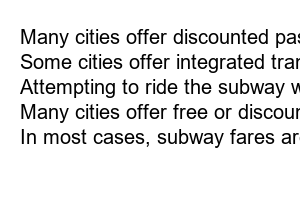지하철 어린이 요금
Subway Fares: Everything You Need to Know
If you’re a regular commuter in a bustling city, chances are you’ve had to deal with the dreaded subway fare at some point. Whether you’re a daily rider or just an occasional user, understanding the ins and outs of subway fares can save you time and money. So, let’s break it down for you:
**What Determines the Subway Fare?**
Subway fares are typically determined by various factors, including the distance traveled, time of day, and whether you’re using a single ride or a pass. The fare structure can vary from city to city, so be sure to check with your local transportation authority for specific details.
**Pricing for Single Rides**
In most cities, a single ride on the subway will cost you a set amount, regardless of the distance traveled. This fee is typically paid at the entrance gate or through a ticket vending machine before boarding the train. Be sure to have exact change or a reloadable transit card to avoid any delays.
**Purchasing Passes**
For frequent riders, purchasing a pass can be a cost-effective option. These passes allow for unlimited rides within a certain timeframe and can save you money in the long run. Be sure to check if your city offers discounted passes for students, seniors, or low-income individuals.
**Peak vs. Off-Peak Fares**
Some cities implement peak and off-peak pricing, where fares are higher during peak travel times, such as rush hour, and lower during off-peak hours. If you have the flexibility, consider traveling during off-peak times to save money on your commute.
**Transfers and Transfers Policies**
If you need to transfer between subway lines or modes of transportation, be aware of transfer policies in your city. Some cities allow free transfers within a certain timeframe, while others may require an additional fare. Plan your route accordingly to avoid any unexpected fees.
**Tips for Saving Money on Subway Fares**
To save money on subway fares, consider purchasing a reloadable transit card, taking advantage of discounted passes, and traveling during off-peak hours. Additionally, try to plan your trips in advance to minimize the number of single rides you take.
**Summary**
In summary, subway fares can vary depending on various factors such as distance, time of day, and fare structures. By understanding the pricing policies in your city and taking advantage of money-saving tips, you can navigate the subway system with ease and save money on your daily commute.
**FAQs**
1. What is the best way to pay for subway fares?
Having a reloadable transit card or purchasing a pass can be the most convenient and cost-effective way to pay for subway fares.
2. Are there any discounts available for subway fares?
Many cities offer discounted passes for students, seniors, and low-income individuals. Be sure to check with your local transportation authority for more information.
3. Can I use the same pass for multiple modes of transportation?
Some cities offer integrated transit systems where a single pass can be used for buses, subways, and other modes of transportation. Check to see if this option is available in your city.
4. What happens if I forget to pay my subway fare?
Attempting to ride the subway without paying the fare can result in fines or other penalties. Be sure to have the correct fare ready before boarding the train.
5. Are children allowed to ride the subway for free?
Many cities offer free or discounted fares for children under a certain age. Check with your local transportation authority for specific policies regarding children’s fares.
6. Can I get a refund if my subway ride is delayed or canceled?
In most cases, subway fares are non-refundable, even in the event of delays or cancellations. Be sure to plan your trips accordingly to avoid any issues.

